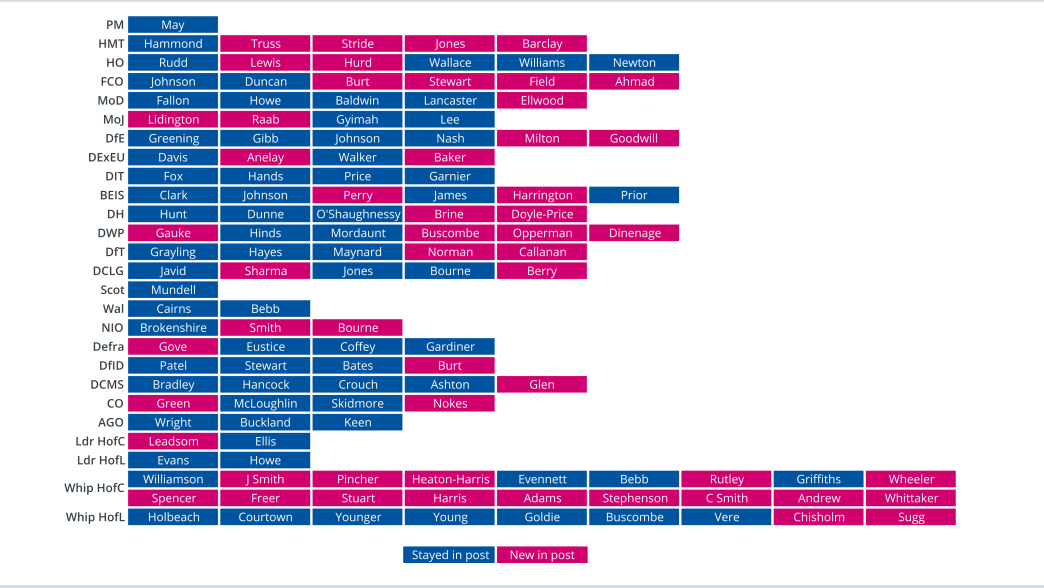
Theresa May’s reshuffle did not look strong or stable from either a political or practical viewpoint, writes Gavin Freeguard, completing the Whitehall Monitor team’s live-blog on the formation of the new government.
Imagine the entire leadership of your organisation changing every couple of years, projects half-started in their old roles, and no help or handover for their new ones. That’s a government reshuffle for you: more focused on political management than what’s best for achieving the Government’s objectives.
This reshuffle arguably managed neither, with continuity at Cabinet level highlighting the Prime Minister’s precarious political position and limited room for manoeuvre, and churn at lower levels making the challenges of minority even more difficult.
And tracking May’s ministerial moves has been challenging. Where David Cameron’s appointments were tweeted out by Number 10 as they happened, May’s were clearly press released as they happened but not published on GOV.UK until many hours later. Why shouldn’t the public – and civil servants – find out at the same time as the press?
Ten ministers – including one Cabinet minister – lost their seats in the General Election.
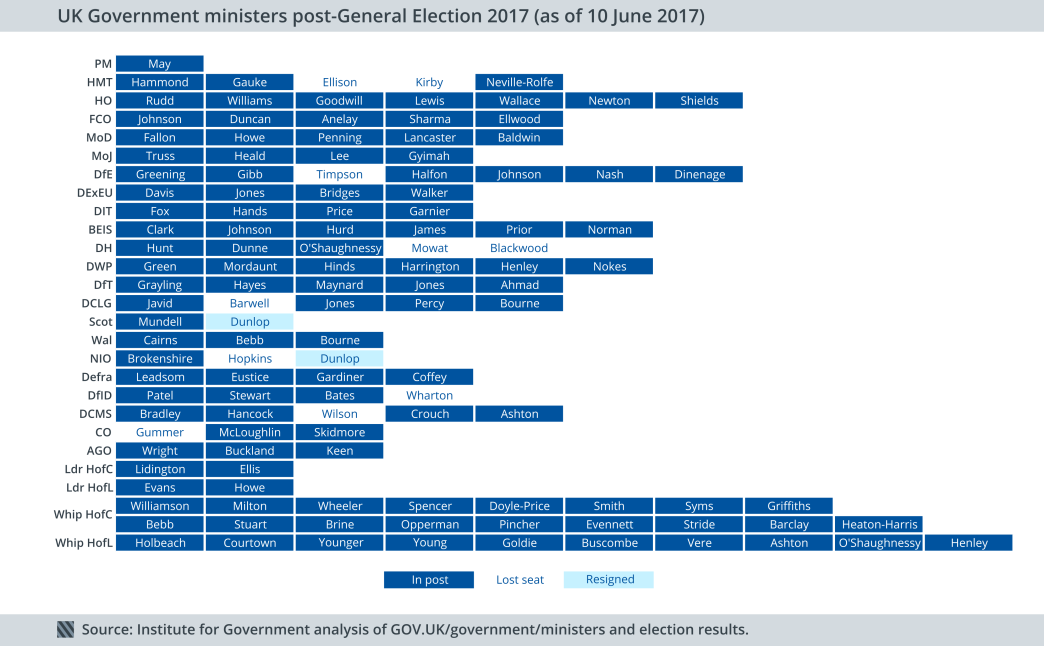
Theresa May lost her majority and ten ministers their seats, including former Cabinet Minister Ben Gummer. With Lord Dunlop also resigning, the Prime Minister had 12 jobs to fill against a background of terrorism, tragedy and talks with the Democratic Unionist Party (DUP) to support her government on a confidence and supply basis.
The result left the Prime Minister unable to reshuffle many ministers at Cabinet level…
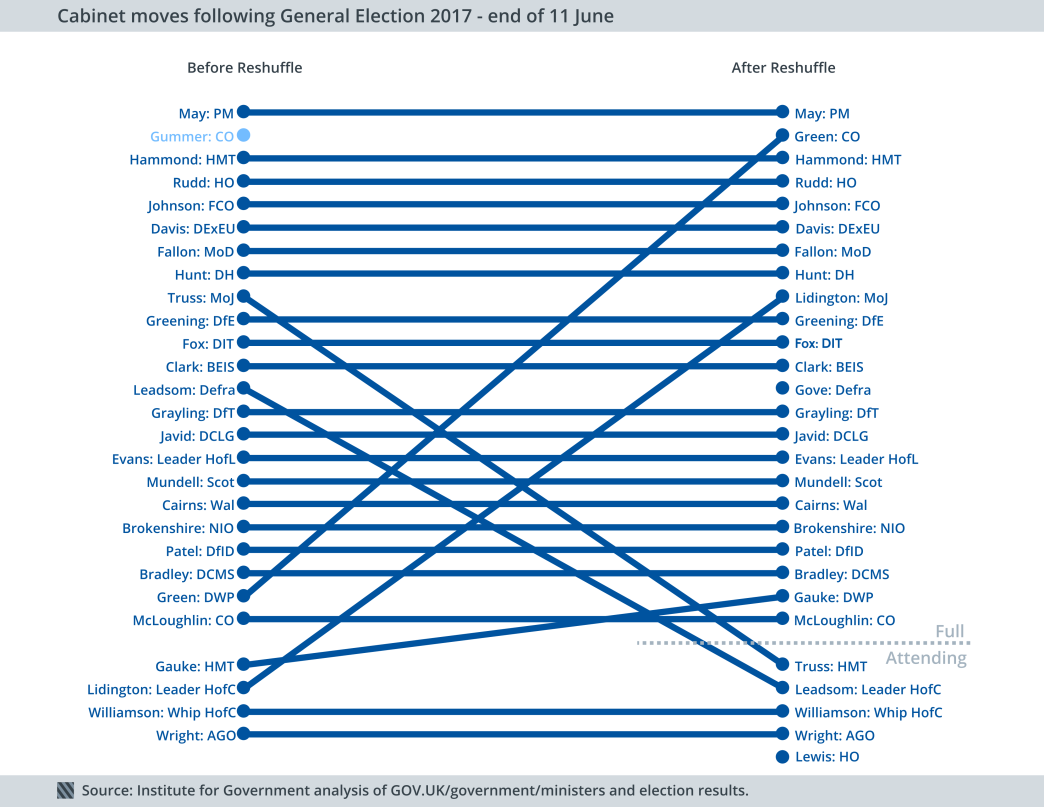
The election result restricted May’s ability to change her Cabinet, with 21 attendees remaining in the same post. Against a backdrop of political turmoil, even the rhythm of the reshuffle was disrupted: it was going to start on Friday afternoon, then it wasn’t, then it did; then it was going to start on Saturday, then it didn’t; then it came out of near nowhere on Sunday afternoon and trickled through the rest of the week – a spillage of cards not a shuffle.
The only Cabinet cards ultimately to end up in a different place were Damian Green, David Gauke, Liz Truss, David Lidington and Andrea Leadsom, who moved; Michael Gove, who re-entered; and Brandon Lewis, who entered. Nobody left apart from Ben Gummer.
Green also became First Secretary of State, a title similar to Deputy Prime Minister, making him “second among equals” behind the Prime Minister. His replacement at DWP by Gauke means we’ve gone from Iain Duncan Smith serving nearly six years as Secretary of State for Work and Pensions to three holders in 15 months. What will that mean for projects like Universal Credit?
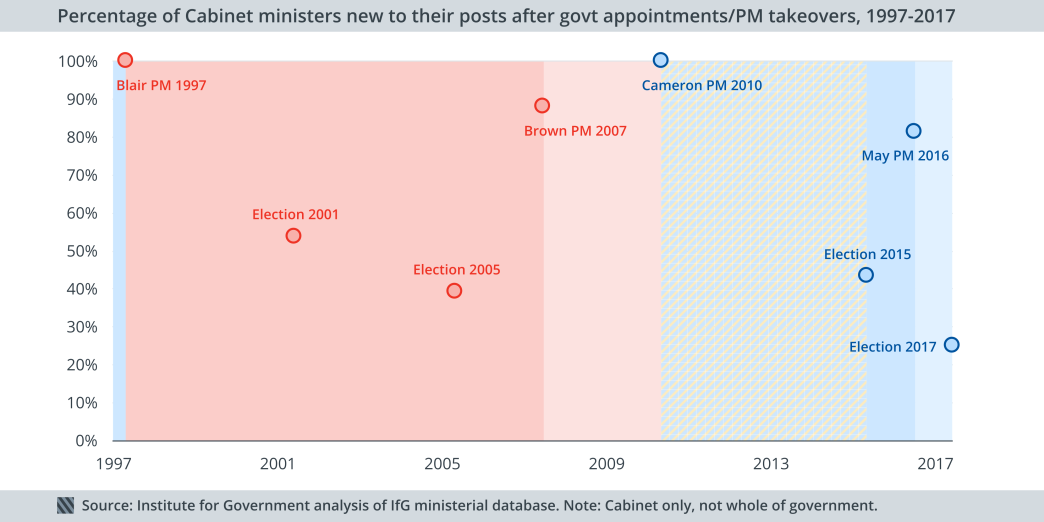
Low turnover would normally be an indicator of strength and stability. This time, the fact that only 25% of Cabinet ministers are new to their posts – much lower than after any other general election, or prime ministerial takeover, since 1997 – emphasises the paucity of the Prime Minister’s political authority, with her unable to follow through on pre-briefed moves.
…but there was much more turnover below Cabinet level: across all of government, 43% of ministers are new to their post.
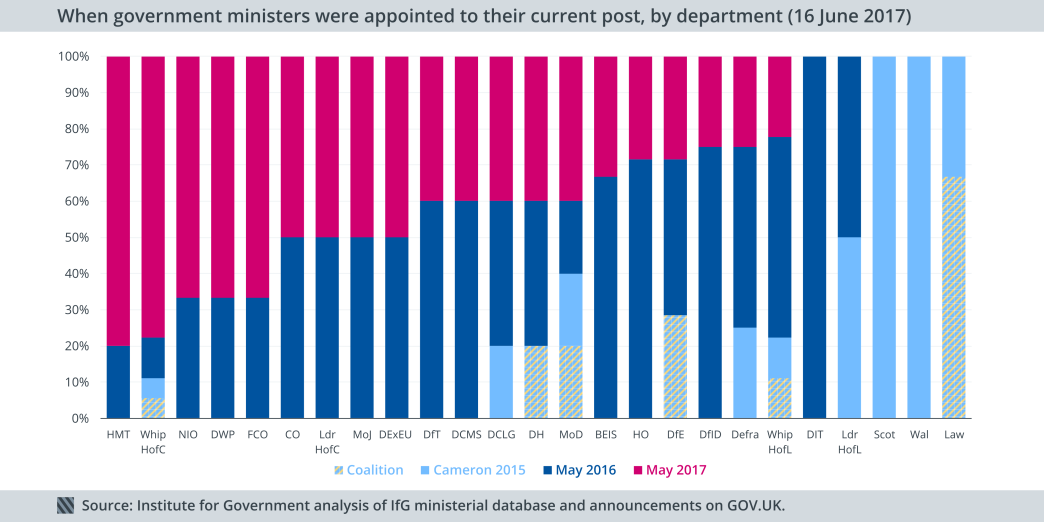
Keeping junior ministers in post long enough for them to understand their brief and follow policies through to implementation is vital. In the event, in nine departments or offices, half or more ministers are new to their post.
The Whips’ Office in the Commons is likely to be particularly important as a minority government attempts to get legislation through. But 14 whips are new to their roles – six have changed position, eight are wholly new to the job.
DExEU ministers exited…
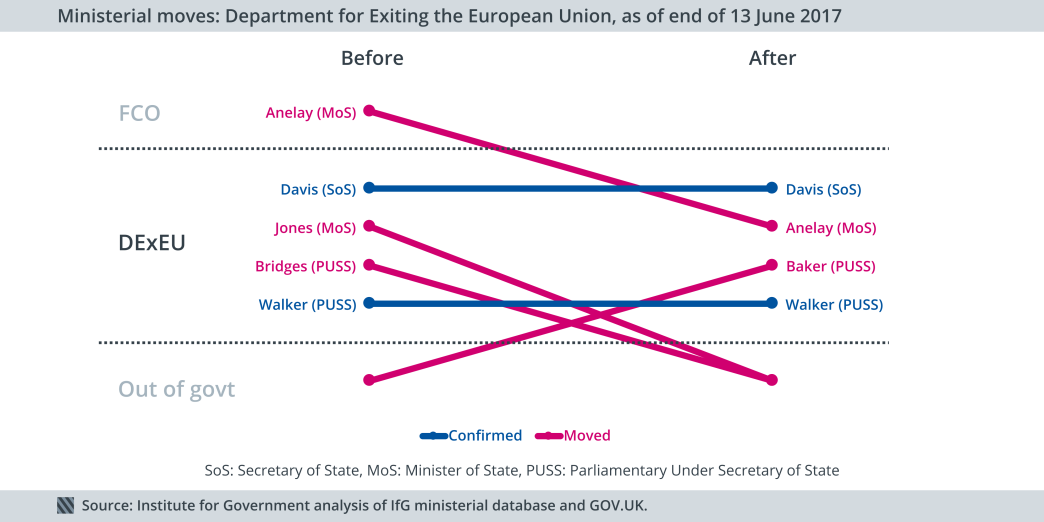
DExEU has attracted the most attention, with half its ministers being replaced a week before Brexit negotiations started.
…and there was more change at the Treasury.
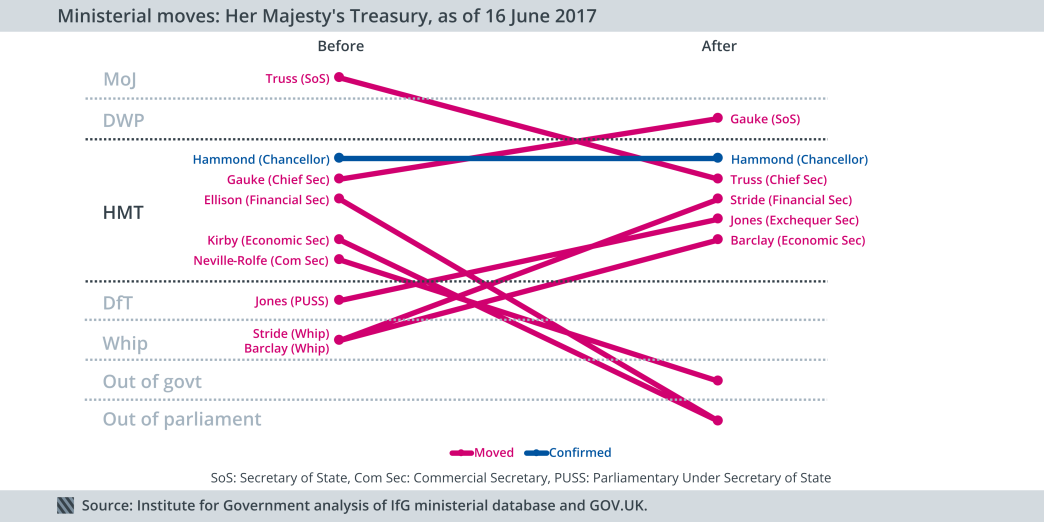
Only the Chancellor, Philip Hammond, remains in post.
Five departments have no female ministers.
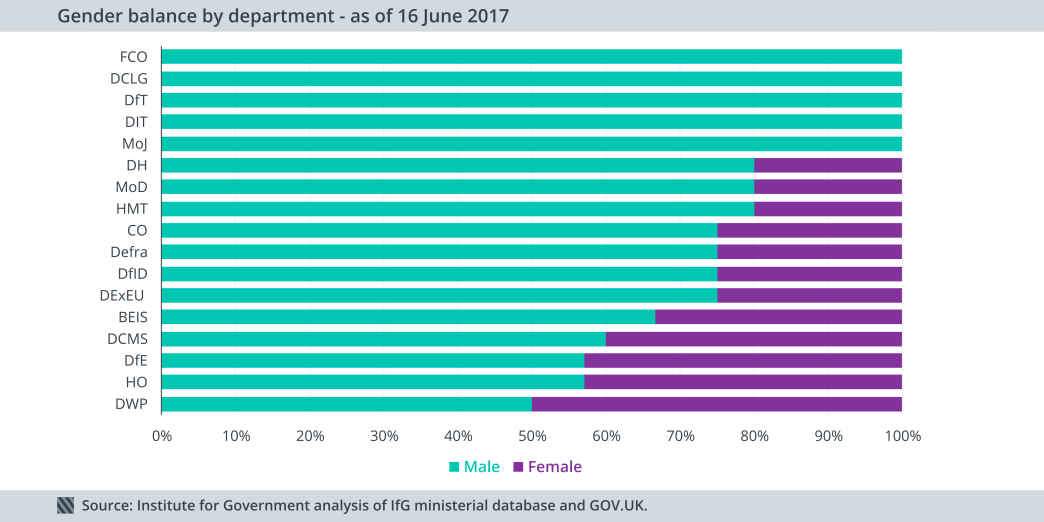
Baroness Anelay became the first female minister at either of the Brexit-related departments formed in July 2016 (DExEU and DIT) when she moved from the Foreign Office to DExEU.
It’s not just what you do, but the way that you do it.
Ironically, Cameron’s more open, more modern social media method of announcing appointments projected a sense of control that May’s closed, command-and-control style could not.
Not being able to confirm portfolios – what policies ministers are responsible for – also doesn’t inspire confidence. This isn’t new – Mark Francois was erroneously announced as Housing Minister under Cameron, while Liam Byrne told us that while pinning down ministerial responsibilities “is the most important thing in the world” for a junior minister, “[f]or the Secretary of State, that’s about tenth on your list of things to be worried about”.
But it’s not currently clear what Caroline Nokes will be doing at the Cabinet Office, the coordinating centre of government. We’ve had two Ministers for Civil Society this week – the third sector press were apparently told it would be John Glen, before eventual confirmation it would be existing DCMS Minister Tracey Crouch, who had originally tweeted her delight at keeping her previous brief.
The Government also confirmed the departure of Baroness Mobarik – who actually left government in April, according to GOV.UK – and confirmed Baroness Chisholm in a post she’d apparently left in December 2016 and is now returning to.
The reshuffle may not have actually finished – The Courier reports that Scottish Tory MEP Ian Duncan will be given a peerage and a role in the Scotland Office.
Reshuffles can be “one of the most potent weapons in the prime ministerial armoury”. But May’s misfiring, stop-start, syncopated reshuffle has demonstrated her weakness, not her strength.
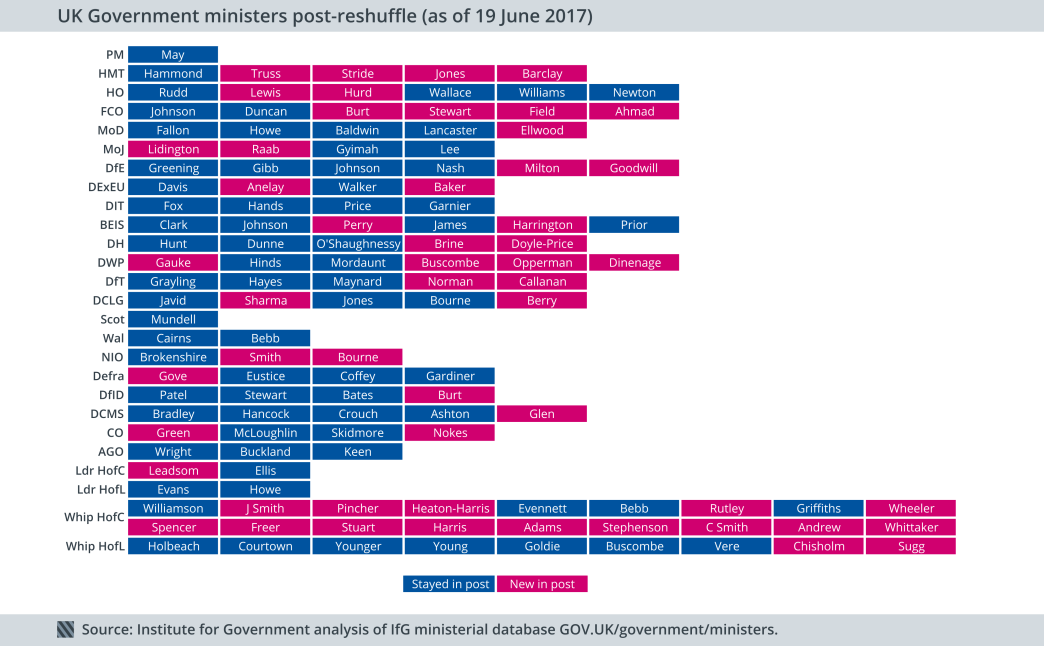
Abbreviations for government departments
This post builds on work from Lucy Campbell, Aron Cheung, Alice Lilly and Gemma Byrne. This is the fourth reshuffle/government formation we’ve live-blogged, after:
- David Cameron’s coalition reshuffle in summer 2014
- Cameron’s Conservative majority formation over three days in May 2015
- Theresa May’s government formation in July 2016.